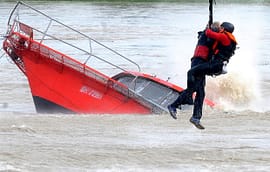 The National Oceanic and Atmospheric Administration (NOAA) operates the Search And Rescue Satellite Aided Tracking System (SARSAT) to detect and locate travelers in distress almost anywhere in the world at anytime and in almost any condition.
The National Oceanic and Atmospheric Administration (NOAA) operates the Search And Rescue Satellite Aided Tracking System (SARSAT) to detect and locate travelers in distress almost anywhere in the world at anytime and in almost any condition.
The NOAA tracking system system uses a network of satellites to quickly detect and locate distress signals from emergency beacons onboard aircraft and boats, and from smaller, handheld personal locator beacons called PLBs.
In 2011, the NOAA satellite tracking system was critical in the rescues of 207 people who were in life-threatening situations throughout the United States and its surrounding waters, according to a Huffington Post blog. Satellites picked up distress signals from emergency beacons carried by downed pilots, shipwrecked boaters and stranded hikers, and relayed the information about their location to first responders on the ground.
Of the 207 saves last year, 122 people were rescued from the water, 14 from aviation incidents, and 71 in land situations where they used their Personal locator beacons (PLBs).
Other rescue highlights from the year include:
- NOAA SARSAT played a critical role in the rescue of a group of student hikers from a grizzly bear attack in Alaska by directing first responders to the scene.
- In the pitch of night, two people were rescued from a life raft after their boat sank 140 miles off the coast of FL.
- An elderly hiker was rescued 74 miles south of Colorado Springs, Colo., during a heavy snowstorm.
About Personal Locator Beacons (PLBs)
For hikers, boaters, pilots, and others who travel to places beyond where cell phone service exists, there are affordable GPS tracking devices called personal locator beacons that can help rescuers find you in the event you have a life threatening emergency. Personal locator beacons can make the difference between life and death.
Outdoor enthusiasts who like to take risks during their adventures should always remember to carry a Personal Locator Beacon (PLB).
When activated, the PLB device transmits a message that’s picked up by satellites orbiting the Earth. An alert is then sent to the NOAA who then notifies the proper rescue authorities.
PLB’s start at about $100, and are worth every penny if lost or stranded with no cell phone signal and you are desperate for help. There are three types of beacons used to transmit distress signals, EPIRBs (for maritime use), ELTs (for aviation use), and PLBs (used for land-based applications).
The tracking devices must be registered with the NOAA to work.